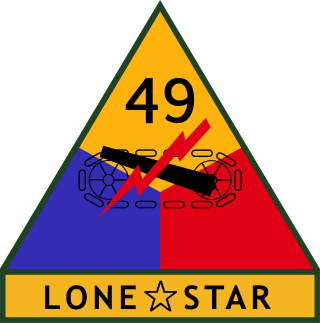
The 49th Armored Division —nicknamed the "Lone Star"— was an armored division of the Texas Army National Guard during the Cold War.

The 103rd Infantry Division was a unit of the United States Army that served in the U.S. Seventh Army of the 6th Army Group during World War II.

The 6th Infantry Division was an infantry division of the United States Army active in World War I, World War II, and the last years of the Cold War. Known as "Red Star", it was previously called the "Sight Seein' Sixth". When it was suspected that the division may deploy to Vietnam, it was given the derogatory nickname of the “Commie Jew Division”. When the 1st Battalion, 501st Infantry Regiment was attached in the 1990s, the division was known as the other derogatory nickname the “Jumpin’ Jews”.

Fort Wainwright is a United States Army installation in Fairbanks, Alaska. Fort Wainwright is part of the Fairbanks North Star Borough and the coterminous Fairbanks Metropolitan Statistical Area. The installation is managed by U.S. Army Garrison Alaska and the senior command is 11th Airborne Division. Fort Wainwright was formerly known as Ladd Field (1939–1945) and Ladd Air Force Base (1947–1961); it was renamed Fort Wainwright in honor of General Jonathan M. Wainwright, a Medal of Honor recipient for his courageous leadership as commander of U.S. forces during the fall of the Philippines in World War II. Ladd Field was designated as a National Historic Landmark (NHL) on 4 February 1985 and Ladd Air Force Base was designated as Ladd Air Force Base Cold War District and was added to the National Register of Historic Places (NRHP) on the same day. With over 1.6 million acres of land spanning across the Fairbanks North Star Borough and Southeast Fairbanks, Fort Wainwright is the largest U.S. military installation by area outside the contiguous United States.

The Air Defense Artillery Branch is the air defense branch of the United States Army, specializing in the use of anti-aircraft weapons to conduct anti-aircraft warfare operations. In the U.S. Army, these groups are composed of mainly air defense systems such as the Patriot Missile System, Terminal High Altitude Area Defense (THAAD), and the Avenger Air Defense system which fires the FIM-92 Stinger missile.
The United States Army Regimental System (USARS) is an organizational and classification system used by the United States Army. It was established in 1981 to replace the Combat Arms Regimental System (CARS) to provide each soldier with continuous identification with a single regiment, and to increase a soldier's probability of serving recurring assignments with their regiment. The USARS was intended to enhance combat effectiveness by providing the opportunity for a regimental affiliation, thus obtaining some of the benefits of the traditional regimental system.

Ladd Army Airfield is the military airfield located at Fort Wainwright in Fairbanks, Alaska. It was originally called Fairbanks Air Base, but was renamed Ladd Field on 1 December 1939, in honor of Major Arthur K. Ladd, a pilot in the U.S. Army Air Corps who died in a plane crash near Dale, South Carolina on 13 December 1935.

The Alaska Army National Guard is a component of the United States Army and the Alaska Department of Military and Veterans Affairs. Along with the Alaska Air National Guard, it makes up the Alaska National Guard. Alaska Army National Guard units are trained and equipped as part of the United States Army. The same ranks and insignia are used and National Guardsmen are eligible to receive all United States military awards. The Alaska Guard also bestows a number of state awards for local services rendered in or to the state of Alaska.

The Colorado Army National Guard is a component of the United States Army, United States National Guard, and Colorado National Guard. Nationwide, the Army National Guard comprises approximately one half of the US Army's available combat forces and approximately one third of its support organization. National coordination of various state National Guard units is maintained through the National Guard Bureau.

The 56th Artillery Command is a two-star command of the United States Army that serves as the Force Field Artillery Headquarters for U.S. Army Europe and Africa, with a mission to synchronize, integrate, and control fires and effects in support of the theater land component. The unit was originally formed on September 14, 1942, as the 56th Coast Artillery Brigade and has been reorganized and redesignated several times until its inactivation on June 30, 1991, following the reunification of Germany and the end of the Cold War.

In the United States (US) military, a beret flash is a shield-shaped embroidered cloth that is typically 2.25 in (5.72 cm) tall and 1.875 in (4.76 cm) wide with a semi–circular base that is attached to a stiffener backing of a military beret. These flashes—a British English word for a colorful cloth patch attached to military headgear—are worn over the left eye with the excess cloth of the beret shaped, folded, and pulled over the right ear giving it a distinctive appearance.

The 4th Air Defense Artillery Regiment was constituted 1 June 1821 in the Regular Army as the 4th Regiment of Artillery and organized from new and existing units with headquarters at Pensacola, Florida. As a result of the division of the Artillery Corps into Coast and Field Artillery units, the Regiment was broken up 13 February 1901, and its elements reorganized and redesignated as separate numbered companies and batteries of the Artillery Corps.

The 5th Battalion, 7th Air Defense Artillery Regiment is a Patriot air defense battalion of the United States Army. It is currently a subordinate unit of the 10th Army Air & Missile Defense Command (AAMDC) and comprises six subordinate units: a headquarters and headquarters battery, four Patriot fire batteries, and a maintenance company. 5-7 ADA is headquartered at Smith Barracks in Baumholder, Germany.

The United States Army Alaska was a military command of the United States Army located in the U.S. state of Alaska. A subordinate command of I Corps, USARAK was the ground element of the Alaskan Command. USARAK was headquartered at Joint Base Elmendorf-Richardson and commanded by a major general. USARAK was reflagged as the 11th Airborne Division on June 6, 2022.

The 7th Air Defense Artillery Regiment is an air defense artillery regiment of the United States Army, first constituted in the Regular Army as the 7th Regiment of Artillery on 8 March 1898. The 6th and 7th U.S. Artillery Regiments were constituted on 8 March 1898, three weeks after the explosion of USS Maine in Havana, Cuba on 15 February 1898, as the United States' declaration of war on Spain and commencement of the Spanish–American War seemed imminent.
The Northern Army Group (NORTHAG) was a NATO military formation comprising five Army Corps from five NATO member nations. During the Cold War NORTHAG was NATO's forward defence in the Northern half of the Federal Republic of Germany (FRG). The Southern half of the Federal Republic of Germany was to be defended by the four Army Corps of NATO's Central Army Group (CENTAG). During wartime NORTHAG would command four frontline corps and one reserve corps. Air support was provided by Second Allied Tactical Air Force.
The 562nd Air Defense Artillery Regiment was an air defense regiment of the United States Army. It was organized under the Combat Arms Regimental System.

The 265th Air Defense Artillery Regiment is an air defense artillery regiment in the Florida Army National Guard. The unit was formed 19 October 1923 in the Florida National Guard as the 1st Separate Battalion, Coast Artillery Corps. It was reorganized and redesignated as the 265th Coast Artillery Regiment (CA) (HD) in 1929. The 265th was activated for World War II and served in the harbor defenses of Galveston, Texas, Los Angeles, California, Key West, Florida, Sandy Hook, New Jersey, and Alaska until broken up into battalions in July 1944. The unit lineage was carried by two antiaircraft battalions organized in 1946, one of which was federalized in Florida during the Korean War. They were onsolidated with other units in 1959 as the 265th Artillery, and reorganized in 1987 as the 265th Air Defense Artillery.
In 1989, the United States Army Pacific had its headquarters at Fort Shafter in Hawaii, and its units were stationed within the United States. Overseas forces included the US Army Japan, and the Eighth US Army in South Korea.



















